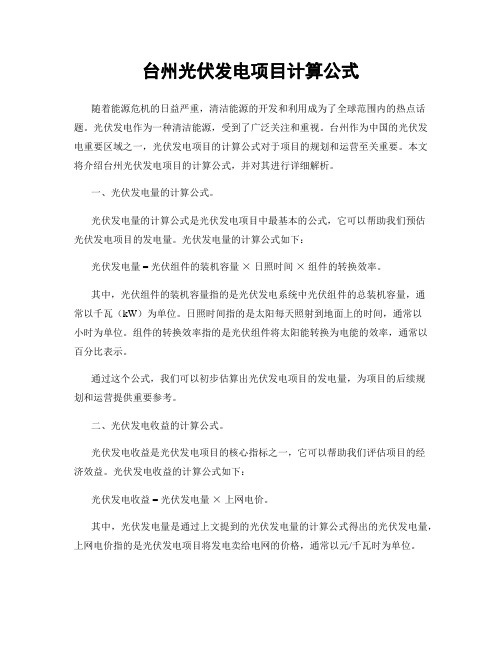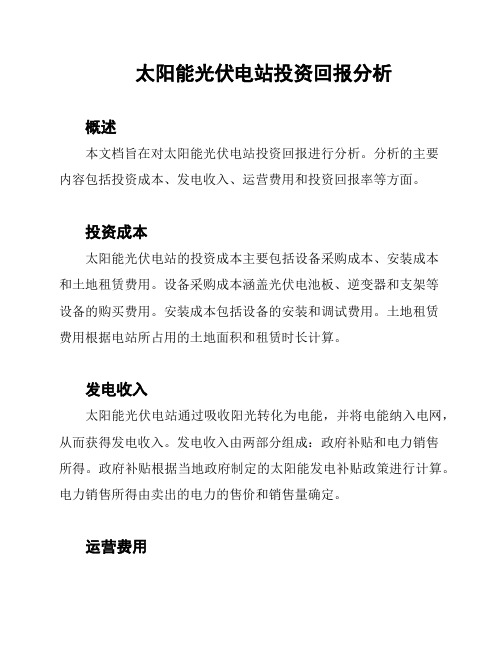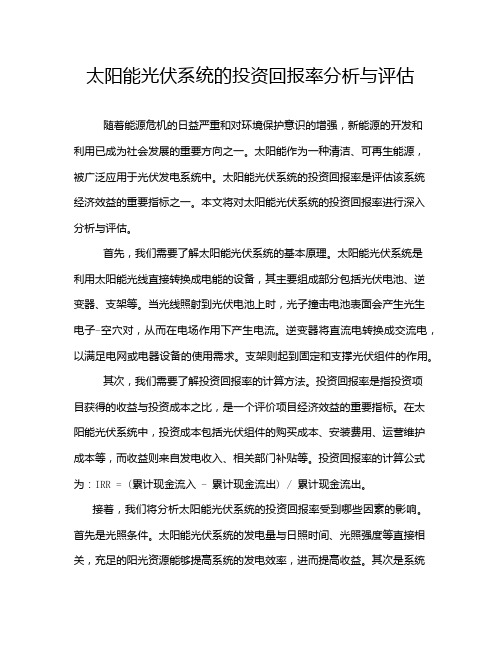太阳能投资回报率计算
光伏电站的投资回报率分析

光伏电站的投资回报率分析在近年来,能源使用模式的转变正在逐步扩大,尤其是追求绿色,低碳和环保的能源。
在这样的氛围下,太阳能发电成为许多投资者的首选。
在太阳能领域中,光伏电站已经成为一种成熟的解决方案。
本文将分析光伏电站的投资回报率,帮助您更好地了解光伏电站的经济优势,以及如何计算光伏项目的实际可行性,减少风险和增加投资收益。
1、光伏电站的定义光伏电站,又称太阳能电站,是指利用太阳能光电转换原理,把光能直接转化为电能的电站。
光伏电站通常由太阳能电池板,逆变器,变压器,电缆和开关设备组成。
2、光伏电站的工作原理光伏电站将太阳能转化为电能的过程是由太阳能电池板完成的。
光伏电站中的太阳能电池板由多个太阳能电池电池片组成,电池片将太阳能辐射转化为直流电能。
当太阳能光线照射到电池片时,电池片中的电子会被激发并流向电池下部,从而产生电流。
这个电流被收集到逆变器中,逆变器将直流电转化为交流电,以供家庭或公用电网使用。
3、光伏电站的投资回报率投资回报率是评估投资项目经济效果的重要指标。
在光伏电站投资领域中,投资回报率非常重要。
它可以帮助投资者判断一个光伏电站是否具有可行性,是不是值得投资。
计算光伏电站的投资回报率可以按照以下步骤:(1)计算总投资成本光伏电站的总投资成本主要包括设备采购成本,人工成本和其他费用。
其中,设备采购成本是主要的投资成本。
(2)计算年发电量年发电量是决定光伏电站电价和收益的关键因素之一。
年发电量的大小与光伏电站的位置,设备类型,角度倾斜,环境因素等都有关系。
(3)计算年可售电量年可售电量的计算方法是:年发电量*(1-损耗率)*电价。
损耗率是指光伏电站在电力输送过程中的损失,电价是政府对电力定的价格。
(4)计算年收益年收益是根据年可售电量和电价计算得出的。
(5)计算投资回报期投资回报期是指光伏电站产生的净现金流量(扣除各种维护保养费用后的现金流),达到总投资成本的时间。
投资回报期越短,说明该光伏电站越具有可行性和吸引力。
分布式光伏roi计算公式

分布式光伏roi计算公式全文共四篇示例,供读者参考第一篇示例:分布式光伏(Distributed PV)是指将光伏发电系统分布在不同地点的建筑物上,与传统的集中式光伏发电相比,分布式光伏具有更灵活的安装方式、更高的系统可靠性、能够避免输电损耗等优点,因此在近年来得到越来越广泛的应用。
而对于投资者或者厂商来说,最关心的问题之一便是投资回报率(ROI)问题。
那么,如何计算分布式光伏系统的ROI呢?我们需要明确ROI的概念。
ROI(Return on Investment)即投资回报率,是用来评估投资项目盈利能力的指标。
ROI的计算公式是:ROI = (投资收益- 投资成本)/ 投资成本* 100%。
在分布式光伏领域,投资收益即为分布式光伏系统的发电收益,而投资成本包括系统的安装、运维、维护等各项费用。
我们需要明确分布式光伏系统的发电收益如何计算。
分布式光伏系统的发电收益主要包括两部分:一是自用电量的节省,二是余电上网收入。
自用电量的节省即通过自己发电实现的电费节省,而余电上网收入则是将多余的电量卖给电网所获得的收益。
在一些地区,政府还会给予太阳能发电补贴,这也算作发电收益的一部分。
我们来看一下分布式光伏系统的ROI计算公式。
分布式光伏系统的ROI可以用以下公式表示:ROI = (Σ(自用电量节省+ 余电上网收入+ 补贴收入)- Σ(安装费用+ 运维费用))/ Σ(安装费用+ 运维费用)* 100%Σ表示求和运算,自用电量节省是通过自发电实现的电费节省,余电上网收入是将多余的电量卖给电网所获得的收益,补贴收入是政府给予的太阳能发电补贴,安装费用包括光伏组件、逆变器、支架、安装人工费用等,运维费用包括系统运行维护、清洗、保险等费用。
通过以上公式计算,投资者便可以得到分布式光伏系统的ROI。
需要注意的是,不同地区的电价、补贴政策、光照条件等因素都会影响到ROI的计算结果,因此在具体实施时需谨慎选择合适的参数进行计算。
太阳能发电项目投资回报率评估

太阳能发电项目投资回报率评估随着环境保护和可再生能源的重要性不断凸显,太阳能发电作为一种清洁、可再生的能源形式受到了广泛关注。
在能源转型的大背景下,越来越多的投资者开始关注太阳能发电项目的投资回报率。
本文将对太阳能发电项目的投资回报率进行评估,并提供相关的分析和建议。
第一部分:太阳能发电项目的概述太阳能发电项目是利用太阳能将光能转化为电能的一种能源项目。
通过安装太阳能电池板并将其与逆变器相连接,太阳能发电项目能够将太阳能转化为直流电,再经过逆变器转化为交流电以供使用或并网销售。
太阳能发电项目具有可再生、环保、分布广泛等特点,被认为是未来能源发展的方向之一。
第二部分:投资回报率的计算方法投资回报率是衡量投资项目盈利能力的一项重要指标。
在计算太阳能发电项目的投资回报率时,需要考虑以下几个关键因素:1. 投资成本:包括太阳能电池板、逆变器、支架安装、电网连接等方面的费用。
2. 发电量:太阳能发电项目的发电量取决于所选用的太阳能电池板的性能、安装角度、日照条件等因素。
3. 售电收入:将多余的电能卖给电网可以获得一定的收入。
售电价格会因地区、政策等不同而有所差异。
4. 电费节省:通过自己使用太阳能发电项目发电而节省的电费也是一种收入。
投资回报率(IRR)计算公式如下:IRR = [CFt / (1 + r)^t] - C0其中,CFt代表第t年的现金流入,r代表贴现率,t代表年份,C0代表初始投资成本。
第三部分:投资回报率评估与分析太阳能发电项目的投资回报率评估对于投资者来说至关重要。
以下是对投资回报率的评估与分析:1. 风险分析:投资太阳能发电项目涉及一定的风险,包括政策风险、市场风险、技术风险等。
投资者需要对这些风险进行充分的了解和评估,并相应调整投资回报率的预期。
2. 政策支持:政府对太阳能发电项目的政策支持以及电价补贴等因素将直接影响投资回报率。
3. 项目规模:太阳能发电项目的规模将对投资回报率产生影响。
台州光伏发电项目计算公式

台州光伏发电项目计算公式随着能源危机的日益严重,清洁能源的开发和利用成为了全球范围内的热点话题。
光伏发电作为一种清洁能源,受到了广泛关注和重视。
台州作为中国的光伏发电重要区域之一,光伏发电项目的计算公式对于项目的规划和运营至关重要。
本文将介绍台州光伏发电项目的计算公式,并对其进行详细解析。
一、光伏发电量的计算公式。
光伏发电量的计算公式是光伏发电项目中最基本的公式,它可以帮助我们预估光伏发电项目的发电量。
光伏发电量的计算公式如下:光伏发电量 = 光伏组件的装机容量×日照时间×组件的转换效率。
其中,光伏组件的装机容量指的是光伏发电系统中光伏组件的总装机容量,通常以千瓦(kW)为单位。
日照时间指的是太阳每天照射到地面上的时间,通常以小时为单位。
组件的转换效率指的是光伏组件将太阳能转换为电能的效率,通常以百分比表示。
通过这个公式,我们可以初步估算出光伏发电项目的发电量,为项目的后续规划和运营提供重要参考。
二、光伏发电收益的计算公式。
光伏发电收益是光伏发电项目的核心指标之一,它可以帮助我们评估项目的经济效益。
光伏发电收益的计算公式如下:光伏发电收益 = 光伏发电量×上网电价。
其中,光伏发电量是通过上文提到的光伏发电量的计算公式得出的光伏发电量,上网电价指的是光伏发电项目将发电卖给电网的价格,通常以元/千瓦时为单位。
提供重要参考。
三、光伏发电系统的建设成本计算公式。
光伏发电系统的建设成本是光伏发电项目的重要成本之一,它直接影响着项目的投资回报率。
光伏发电系统的建设成本计算公式如下:光伏发电系统的建设成本 = 光伏组件的装机容量×单位容量造价。
其中,光伏组件的装机容量和单位容量造价分别指的是光伏发电系统中光伏组件的总装机容量和单位装机容量的造价,通常以千瓦和元/千瓦为单位。
通过这个公式,我们可以初步估算出光伏发电项目的建设成本,为项目的投资决策提供重要参考。
四、光伏发电系统的运维成本计算公式。
太阳能光伏系统的建设成本与回报分析

太阳能光伏系统的建设成本与回报分析随着环境保护意识的增强和可再生能源的发展,太阳能光伏系统作为一种清洁能源逐渐受到人们的重视。
然而,对于许多人来说,他们更关心的是太阳能光伏系统的建设成本以及投资回报情况。
本文将对太阳能光伏系统的建设成本与回报进行分析。
1. 建设成本太阳能光伏系统的建设成本主要包括光伏组件、支架、逆变器、电池、电线等硬件设备的费用,以及安装、调试、维护等人工费用。
根据不同型号和规格的光伏系统,建设成本也会有所不同。
一般来说,小型家用光伏系统的建设成本较低,而大型商业光伏系统的建设成本较高。
2. 投资回报太阳能光伏系统的投资回报主要包括两个方面:一是节约电费,二是卖电上网。
太阳能光伏系统通过转换太阳能为电能,可以自给自足地为家庭或商业使用提供电力,从而减少了因为购买电力而产生的费用。
同时,如果系统产生的电力超过了使用量,还可以将多余的电力卖给电网,享受上网电价。
3. 成本与回报分析对于太阳能光伏系统的建设成本与回报,需要进行详细的分析。
首先,要考虑系统的实际发电量,根据当地的太阳能资源状况进行评估。
其次,要考虑电价的变化情况,以及政府对太阳能光伏系统的政策支持。
最后,要根据系统的寿命和维护成本进行综合评估。
综合以上因素,可以得出太阳能光伏系统在长期运行下的投资回报率。
一般来说,太阳能光伏系统的投资回报周期较长,一般在8-12年左右。
然而,随着技术的不断发展和成本的不断降低,太阳能光伏系统的回报周期也在逐渐缩短。
总的来说,太阳能光伏系统的建设成本与回报分析是一个复杂的过程,需要考虑到诸多因素。
然而,随着环保意识的提高和政策的支持,太阳能光伏系统作为一种清洁能源,仍然具有广阔的发展前景。
希望本文的分析可以为您对太阳能光伏系统的建设成本与回报有所了解。
太阳能发电项目经济效益评估

太阳能发电项目经济效益评估随着环境保护和可再生能源的意识不断增强,太阳能发电作为一种清洁能源,受到了广泛关注。
本文将对太阳能发电项目的经济效益进行评估,分析其投资回报率、成本效益以及对社会、环境的影响。
通过深入探讨,旨在给出一个客观准确的评估结果,帮助决策者做出明智的决策。
1. 项目背景太阳能发电项目是一项利用太阳能转化为电力的工程,通过太阳能电池板将太阳能转化为直流电,再通过逆变器将其转化为交流电供给家庭、企业及公共设施使用。
太阳能发电具备环保、可再生、分布广泛等显著特点,被普遍认为是未来发展的重要方向。
2. 投资回报率评估投资回报率(IRR)是衡量投资项目利润率的重要指标,它可以评估太阳能发电项目的经济效益。
IRR计算方法如下:IRR = (\sum_{t=0}^{n} CF_t / (1+r)^t) - C_i其中,CF_t表示每年的现金流入,r为折现率,C_i为初始投资成本。
通过计算得到的IRR值,可以判断太阳能发电项目是否具备可行性。
一般来说,IRR越高,投资回报越快,项目越具吸引力。
3. 成本效益评估成本效益是评估太阳能发电项目经济效益的另一个重要指标。
成本效益分析可以从多个角度进行,包括成本效益比、净现值、内部收益率等。
3.1 成本效益比成本效益比是将项目的当前价值与成本进行比较的指标。
计算公式如下:B/C = NPV / C_i其中,NPV表示净现值,C_i表示初始投资成本。
当成本效益比大于1时,表明太阳能发电项目具备可行性和经济效益。
3.2 净现值净现值是将项目所有现金流入和现金流出的综合影响考虑在内,计算项目总体经济效益的指标。
净现值计算方法如下:NPV = \sum_{t=0}^{n} (CF_t / (1+r)^t) - C_i计算得到的净现值如果为正,则表明太阳能发电项目具备经济效益。
3.3 内部收益率内部收益率(IRR)是使得净现值等于0的折现率。
计算内部收益率的具体方法如上所述,通过计算IRR,可以判断项目的可行性。
屋顶安装太阳能发电投资回报计算

屋顶安装太阳能发电投资回报计算
某建筑物屋顶安装太阳能面积约1200平方米,估算太阳能光伏组件容量和年发电量,投资回报计算。
一.太阳能发电技术部分
1.标准光伏组件技术参数
2.武汉市气象指标
3.安装设备容量估算
按照可以安装光伏组件实际面积利用系数取0.6,1个标准光伏
组件占地面积按1.8平方考虑。
安装数量约n= 1200∗0.6
=400块
1.8
安装功率约400*235W=94kW
4. 年发电量估算
1kW光伏组件平均日发电量约3.1kW·h,其他损耗综合系数取0.8。
年发电量约为:94*3.1*0.8*365=85089kW·h
二.太阳能发电投资部分
每块光伏组件成本约1500元/块,电气管线,逆变器,汇流排等其他辅助部分造价约5万元,每度电按照商业用电考虑0.8元/(kW·h)。
投资成本约1500*400+50000=650000元
每年发电量回报成本约85089*0.8=68071元
回收成本需要年限650000/68071=9.5年。
太阳能发电项目投资回报分析报告

太阳能发电项目投资回报分析报告一、背景介绍太阳能发电是利用太阳能光热或光电效应将太阳能转化为电能的一种可再生能源。
近年来,随着环境保护意识的增强和对可持续能源的需求,太阳能发电项目逐渐成为投资者关注的热点,本报告旨在对太阳能发电项目的投资回报进行深入分析。
二、投资项目概况本项目计划建设一座太阳能发电站,位于某地区,占地面积约XXX平方米,装机容量为XXX千瓦。
项目建设期为X年,运营期为X年。
三、投资成本分析1. 建设投资建设投资包括土地购置费、设备采购费、工程施工费、系统调试费等。
具体投资金额如下:- 土地购置费:XXX万元- 设备采购费:XXX万元- 工程施工费:XXX万元- 系统调试费:XXX万元总建设投资为XXX万元。
2. 运营成本运营成本主要包括维护费用、设备折旧费用、人力成本等。
根据过往数据及市场调研,每年的运营成本预计为XXX万元。
四、收入预测太阳能发电项目的收入主要来自于发电收益。
根据地区的日照资源、政策支持等因素,经过综合分析得出如下的收入预测数据:- 年发电量:XXX万千瓦时- 发电收益:XXX万元/年(按国家电网购电价格计算)年发电收益为XXX万元。
五、投资回报分析1. 投资回收期投资回收期是指从项目投资开始到回收全部投资的时间。
根据投资金额、每年发电收益等数据,通过计算得出该项目的投资回收期为X 年。
2. 净现值净现值是将所有现金流量按照一定折现率计算后所得到的价值。
根据项目的投资金额、每年发电收益和折现率,通过计算得出该项目的净现值为XXX万元。
3. 内部收益率内部收益率是指使得项目所有现金流量按照一定折现率的净现值等于零的收益率。
通过计算,得出该项目的内部收益率为X%。
六、风险分析1. 市场风险太阳能发电市场受光伏组件价格波动、电力市场政策调整等因素的影响,具有一定的市场风险。
2. 天气风险太阳能发电受天气条件的限制。
天气恶化或连续阴雨天气可能导致发电量下降,进而影响收益。
居民屋顶光伏发电投资收益与回本周期计算

居民屋顶光伏发电投资收益与回本周期计算投资收益是指通过投资获得的回报,对于居民屋顶光伏发电来说,投资收益主要体现在两个方面:一是通过发电卖给电网获取的电费收入,二是通过国家和地方政府给予的补贴。
首先,我们来计算通过发电卖给电网获取的电费收入。
光伏发电系统的发电量取决于太阳能的辐射强度和系统的装机容量。
以一户普通家庭来说,光伏发电系统的装机容量一般在3-5千瓦之间。
假设一个家庭的屋顶安装了4千瓦的光伏发电系统,系统的年发电量为4000度。
根据国家能源局规定的居民生活用电电价,每度电的价格为0.55元。
那么该家庭一年的电费收入为4000*0.55=2200元。
其次,我们来计算通过国家和地方政府给予的补贴。
根据国家能源局的政策,居民屋顶光伏发电的补贴金额为每度电0.42元。
那么该家庭一年的补贴收入为4000*0.42=1680元。
以上是居民屋顶光伏发电的收入计算,接下来我们来计算回本周期。
回本周期是指当投资收益达到投资成本时的时间。
居民屋顶光伏发电的投资成本主要包括光伏发电系统的购置费用和安装费用。
根据市场调查,4千瓦的居民屋顶光伏发电系统的购置费用和安装费用大约为4-6万元。
假设购置和安装费用为5万元,那么回本周期为5/(2200+1680)=2.27年。
可以看出,居民屋顶光伏发电的投资收益较为可观,并且回本周期相对较短。
值得注意的是,以上计算仅为一种假设情况,实际的投资收益和回本周期还需要根据具体的环境、太阳能辐射强度和政策等因素进行调整。
此外,除了直接卖给电网获得电费收入和政府的补贴之外,居民屋顶光伏发电还有其他可变现的途径,如自用电量的减少和余电的售卖等。
这些因素的存在将进一步提高投资收益和缩短回本周期。
总之,居民屋顶光伏发电的投资收益和回本周期是受到多方面因素影响的,包括装机容量、发电量、电费价格、补贴政策和其他可变现途径等。
在进行投资决策时,居民需要综合考虑这些因素,并对具体情况进行详细的计算和分析,以便做出正确的决策。
光伏项目的投资回报率分析与建议

光伏项目的投资回报率分析与建议光伏项目(Photovoltaic Project)是指利用太阳能把太阳辐射转化为电能的项目。
近年来,随着环保意识的提高以及可再生能源的重要性被逐渐认识,光伏项目在全球范围内得到了广泛应用和推广。
然而,投资回报率(Return on Investment,ROI)作为评估一个项目是否值得投资的重要指标,对于光伏项目的投资决策来说显得尤为重要。
本文将对光伏项目的投资回报率进行分析,并提出相关建议。
一、投资回报率的概念与计算方法投资回报率是衡量投资项目收益能力的指标,它反映了投资方案的经济效益。
计算投资回报率的方法主要有两种:简化投资回报率和加权平均投资回报率。
简化投资回报率是用于评估项目整体回报水平的方法。
计算公式如下:简化投资回报率 = (项目的总收益 - 项目的总投资)/ 项目的总投资加权平均投资回报率是用于评估项目不同阶段回报水平的方法。
计算公式如下:加权平均投资回报率= ∑(项目的每阶段收益 * 每阶段所占投资比例)/ 项目的总投资二、光伏项目的投资回报率分析光伏项目的投资回报率受到以下几个因素的影响:1. 太阳辐射情况:不同地区太阳辐射情况存在差异,较高的太阳辐射可以提高光伏项目的发电效率,从而增加投资回报率。
2. 组件效率:光伏组件的效率越高,单位面积上的发电量就越大,因此可以增加投资回报率。
3. 年发电量和销售电价:年发电量的增加和销售电价的上升可以提高项目的收益,增加投资回报率。
4. 设备成本和维护费用:光伏项目的设备成本较高,且需要定期维护,这些费用将直接影响投资回报率。
基于以上因素,我们可以对光伏项目的投资回报率进行如下分析:1. 地区选择:选择日照充足的地区建设光伏项目,可以提高光伏发电的效率,从而增加投资回报率。
2. 组件选择:选择高效率的光伏组件,可以增加单位面积的发电量,提高投资回报率。
3. 销售电价谈判:与电力公司进行谈判,争取较高的销售电价,以增加项目收益。
太阳能光伏电站投资回报分析

太阳能光伏电站投资回报分析
概述
本文档旨在对太阳能光伏电站投资回报进行分析。
分析的主要
内容包括投资成本、发电收入、运营费用和投资回报率等方面。
投资成本
太阳能光伏电站的投资成本主要包括设备采购成本、安装成本
和土地租赁费用。
设备采购成本涵盖光伏电池板、逆变器和支架等
设备的购买费用。
安装成本包括设备的安装和调试费用。
土地租赁
费用根据电站所占用的土地面积和租赁时长计算。
发电收入
太阳能光伏电站通过吸收阳光转化为电能,并将电能纳入电网,从而获得发电收入。
发电收入由两部分组成:政府补贴和电力销售
所得。
政府补贴根据当地政府制定的太阳能发电补贴政策进行计算。
电力销售所得由卖出的电力的售价和销售量确定。
运营费用
太阳能光伏电站的运营费用包括维护费用、运行监测费用和人员工资等。
维护费用用于设备的日常维护和检修。
运行监测费用用于监测电站的运行情况和数据采集。
人员工资包括对电站人员的薪资支出。
投资回报率
投资回报率是评估太阳能光伏电站投资回报效果的指标。
它通过计算净现值、内部收益率和简化投资回报期等指标来衡量投资的盈利能力和回收时间。
投资回报率越高,说明投资效果越好。
结论
太阳能光伏电站的投资回报受到投资成本、发电收入和运营费用等因素的影响。
在进行投资决策时,应综合考虑这些因素,并根据实际情况进行分析和评估。
通过合理规划和管理,太阳能光伏电站具有可观的投资回报潜力。
太阳能光伏发电系统的投资回报率分析

太阳能光伏发电系统的投资回报率分析引言太阳能光伏发电系统作为一种清洁、可再生的能源利用方式,正逐渐受到世界各国的关注和重视。
在不断上升的能源需求和日益紧迫的环保压力下,投资太阳能光伏发电系统已被许多投资者视为一种具有潜在回报的长期投资。
本文将对太阳能光伏发电系统的投资回报率进行详细分析,以帮助投资者更好地了解其潜在收益和风险。
1. 太阳能光伏发电系统的基本原理太阳能光伏发电系统是通过将太阳能转化为电能的一种发电方式。
其基本原理是利用光伏效应,将太阳辐射能转化为直流电能。
太阳能光伏发电系统主要由太阳能电池板、逆变器、储能系统和电网互联等组成。
2. 太阳能光伏发电系统的优势相比传统的化石燃料发电方式,太阳能光伏发电系统具有以下几个优势:•清洁环保:太阳能是一种可再生能源,利用太阳能发电可以减少对化石燃料的依赖,降低二氧化碳等温室气体的排放,对环境无污染。
•维护成本低:太阳能光伏发电系统维护成本相对较低,只需定期清洁和检查设备运行状态即可。
•长期收益稳定:太阳能光伏发电系统的运行寿命较长,通常可达25年以上,安装一次即可持续产出电能,投资长期稳定。
•分布式发电:太阳能光伏发电系统可灵活安装在建筑物屋顶、地面或太阳能光伏发电站等地方,充分利用空间资源,实现分布式发电。
3. 投资回报率的定义和计算方法投资回报率是评估投资项目收益性的重要指标,它用于衡量投资项目的产出和投入之间的比率,通常以百分比形式表示。
投资回报率的计算公式如下:\[ \text{投资回报率} = \left( \frac{\text{项目收益}}{\text{投资成本}} \right) \times 100 \%\]4. 太阳能光伏发电系统的投资成本太阳能光伏发电系统的投资成本主要包括设备采购、安装和连接电网的费用。
具体投资成本会受到多种因素的影响,包括系统容量、组件品质、安装位置等。
以典型的太阳能光伏发电系统为例,假设系统容量为100kW,设备采购成本为10万元,安装和连接电网的费用为5万元。
太阳能光伏项目投资回报分析

太阳能光伏项目投资回报分析随着全球对可再生能源需求的增加以及环境保护的迫切性,太阳能光伏项目成为了各国政府和企业的重点关注对象。
本文将对太阳能光伏项目的投资回报进行分析,以帮助投资者更好地评估该项目的潜在收益和风险。
1. 市场背景分析太阳能光伏市场正在迅速发展,全球尤其是亚洲地区的太阳能光伏装机容量呈指数级增长。
此外,各国政府积极推动可再生能源政策,为太阳能光伏项目的发展提供了良好的政策和经济环境。
2. 投资回报指标在进行太阳能光伏项目投资回报分析时,我们将使用以下指标:- 净现值(NPV):用于衡量项目是否为投资者创造经济价值。
- 内部收益率(IRR):表示项目的收益率,即项目投资的回报率。
- 投资回收期(Payback Period):项目资本投资回收所需的时间。
3. 成本分析太阳能光伏项目的成本主要包括:- 建设成本:光伏电池板、逆变器、电缆、支架和安装费用等。
- 运营和维护成本:包括人力资源、运输、设备维护和清洁等。
- 操作成本:与发电过程相关的交流、变电等费用。
4. 收益分析太阳能光伏项目的收益主要来自以下几个方面:- 销售电力:将所产生的太阳能电力卖给电网,按照协议价格进行结算。
- 环境效益:减少对化石燃料的依赖,减少二氧化碳和其他污染物的排放。
- 政府补贴:一些国家和地区提供太阳能发电的补贴政策,增加项目收益。
5. 风险分析太阳能光伏项目的风险主要包括:- 政策风险:政府可能调整补贴政策或限制发电容量。
- 市场风险:电力市场价格波动、电网接纳能力等。
- 技术风险:光伏电池板效率下降、设备损坏等。
6. 实例分析以某光伏项目为例进行投资回报分析。
该项目总投资为1000万元,预计年发电量为1000万度,协议售电价为0.8元/度。
运营和维护成本为每年50万元,项目寿命为25年。
根据以上数据,假设资本金的折现率为5%,计算得到的投资回报指标如下:- 净现值(NPV):约为2500万元,表示项目创造了经济价值。
太阳能光伏系统的成本与投资回报分析

太阳能光伏系统的成本与投资回报分析随着可再生能源的受欢迎程度不断增加,太阳能光伏系统作为一种清洁能源解决方案,受到了广泛的关注。
本文将对太阳能光伏系统的成本与投资回报进行详细分析,以帮助读者更好地理解其经济效益。
一、太阳能光伏系统成本分析太阳能光伏系统的成本主要包括设备费用、安装费用和维护费用等。
设备费用是指太阳能电池板、逆变器和电池等的购买成本。
安装费用包括安装人工费用和材料费用。
维护费用涉及到定期检查、清洁和维修等。
以下将对每个方面进行详细分析。
1. 设备费用太阳能电池板是太阳能光伏系统的核心组件,其价格受到材料和技术的影响。
一般而言,随着技术的进步,太阳能电池板的价格逐渐下降。
逆变器和电池的价格也相对较高,但其寿命较长,一次投资可以用于多个项目。
2. 安装费用太阳能光伏系统的安装需要专业人员进行,因此会产生一定的人工费用。
此外,还需要购买一些安装所需的材料,如电缆、支架和支持结构等。
这些费用通常与项目的规模和复杂程度相关。
3. 维护费用为了确保太阳能光伏系统的正常运行和发电效率,需要进行定期的检查、清洁和维修工作。
这些费用虽然不算太高,但是也需要预留一定的经费。
二、太阳能光伏系统投资回报分析太阳能光伏系统的投资回报是指通过发电所获得的收入与投资成本之间的关系。
以下因素将影响投资回报的计算。
1. 发电量太阳能光伏系统的发电量取决于地理位置、太阳辐射情况和系统容量等因素。
通常情况下,系统容量越大,发电量越多。
2. 收益方式发电产生的收益可以通过自用、售电以及国家补贴等进行。
自用意味着通过自家使用电能来降低能源消耗。
售电则可以将多余的电能出售给电网,并获得相应的收入。
此外,一些国家提供太阳能光伏补贴,可以进一步增加投资回报。
3. 投资成本和回收期太阳能光伏系统的投资成本和回收期是影响投资回报的重要因素。
投资成本越低,回收期越短,投资回报越高。
综合考虑上述因素,可以利用财务模型和预测数据来计算太阳能光伏系统的投资回报率(IRR)和回收期。
分布式光伏发电投资回报计算

分布式光伏发电投资回报计算
一、光伏发电投资回报
1、光伏发电投资回报概述
分布式光伏发电,通常称为细分布式发电,指的是发电装置安装在用户的屋顶,以及低压输电线路或高压网络上,以及其他适当方式布置在用户家庭或企业的内部,并从中发电的过程。
通常,用户将发电装置连接到一个虚拟电网,并通过单一变电站的变速器降低发电装置的功率,从而使发电装置不受局部电力网络的干扰。
分布式光伏发电技术主要应用在分散的低压网络上,以获得更大的投资回报。
然而,该技术也可以用于高压网络,以获得更高的发电效率。
2、光伏发电投资回报的分析
(1)购买成本:由于分布式发电装置的工厂价格相对较低,最终用户在安装费用和购买成本等方面的投资也相对较低。
(2)安装费用:考虑到分布式发电装置安装费用较低,可以使分布式发电装置安装成本较低,从而降低投资回报期限。
(3)光照强度:由于分布式发电装置性能取决于照度,因此,分布式发电装置投资回报率也受到光照强度影响。
新能源发电技术的投资回报率分析

新能源发电技术的投资回报率分析随着全球对环境保护的重视程度不断提高,新能源发电技术逐渐成为人们关注的焦点。
在过去的几十年里,太阳能、风能、水能等新能源发电技术得到了广泛的应用和推广。
然而,对于投资者来说,最重要的问题之一就是新能源发电技术的投资回报率。
一、太阳能发电技术的投资回报率分析太阳能发电技术是目前最为成熟和广泛应用的新能源发电技术之一。
太阳能电池板的价格逐渐下降,效率逐渐提高,使得太阳能发电成本逐渐降低。
根据市场研究机构的数据,太阳能发电的投资回报率在不同地区和规模的项目中有所差异,但通常在5%至15%之间。
太阳能发电技术的投资回报率受多种因素影响,包括太阳能资源的可利用程度、电价水平、政府补贴政策等。
在充足的太阳能资源地区,如沙漠地区,太阳能发电的投资回报率往往较高。
此外,政府的补贴政策也是影响太阳能发电技术投资回报率的重要因素。
一些国家和地区通过提供补贴或优惠政策来鼓励太阳能发电技术的应用,这些政策可以大大提高投资回报率。
二、风能发电技术的投资回报率分析风能发电技术是另一种受到广泛关注和应用的新能源发电技术。
相比太阳能发电,风能发电的投资回报率通常更高。
根据国际能源署的数据,风能发电的投资回报率在10%至20%之间,高于太阳能发电。
风能发电技术的投资回报率受到风能资源的可利用程度、电价水平、风机效率等因素的影响。
在风速较高、稳定的地区,风能发电的投资回报率往往较高。
此外,风能发电技术的规模也会影响投资回报率。
通常情况下,大型风电场的投资回报率更高,因为规模效应可以降低发电成本。
三、水能发电技术的投资回报率分析水能发电技术是最早应用的新能源发电技术之一,其投资回报率也相对较高。
根据国际能源署的数据,水能发电的投资回报率在5%至15%之间。
水能发电技术的投资回报率受到水资源的可利用程度、电价水平、水电站效率等因素的影响。
在水资源丰富的地区,水能发电的投资回报率往往较高。
此外,水电站的规模也会影响投资回报率。
投资回报分析报告预测项目的投资回报率

投资回报分析报告预测项目的投资回报率投资回报分析报告预测项目的投资回报率随着经济的不断发展,越来越多的人开始关注投资回报率。
投资回报率(ROI)是衡量投资效果的重要指标,是投资者评估项目可行性和效益的关键因素。
本报告将分析并预测某项目的投资回报率,并为投资者提供参考和决策依据。
1. 项目背景和概述本项目是一家新能源公司计划开发的太阳能电站,旨在利用可再生能源,提供清洁的电力和节能环保的解决方案。
该项目的总投资额为1亿元人民币,并计划在五年内建设完成。
项目的预计生命周期为25年。
2. 投资回报率的计算方法投资回报率是通过对项目的预期收益和投资成本进行比较得出的。
其计算公式为:投资回报率 =(预期收益 - 投资成本)/ 投资成本 * 1003. 投资回报率的预测与分析为了对该项目的投资回报率进行预测和分析,我们采用了三种方法:敏感性分析、财务模型分析和市场需求分析。
a. 敏感性分析敏感性分析是通过对关键变量进行多次模拟和调整,来衡量这些变量对投资回报率的影响程度。
我们对太阳能电站的建设成本、运营成本、年发电量和电价等关键变量进行了敏感性分析。
结果显示,在较为保守的预测下,该项目的投资回报率最低可以达到8%。
b. 财务模型分析财务模型分析是以财务指标为基础,对项目的经济效益进行量化和评估。
我们使用现金流量分析和财务比率分析等方法,对该项目的投资回报率进行了预测。
结果显示,在现金流量充裕的情况下,该项目的投资回报率可预计达到15%。
c. 市场需求分析市场需求分析是通过对市场容量、供求关系和竞争态势等因素进行综合研究,来预测项目的市场接受度和发展潜力。
我们结合太阳能产业的发展趋势和政府政策支持,对该项目的市场需求进行了分析。
结果显示,该项目在当前市场环境下具有良好的前景和潜力,可以为投资者带来可观的投资回报率。
4. 风险和不确定性因素在投资回报率的预测和分析过程中,我们也要考虑到风险和不确定性因素。
例如,政府政策的变化、市场需求波动、技术突破和竞争加剧等都可能对项目的投资回报率产生影响。
太阳能发电技术及经济分析

太阳能发电技术及经济分析随着环保意识的不断提高,人们开始寻找更加环保和可持续的能源替代传统的化石燃料。
太阳能作为一种无限而且清洁的能源,被越来越多的人所认可。
太阳能发电技术也在不断完善,成为当今最为成熟的可再生能源之一。
本文将围绕太阳能发电技术及其经济分析进行探讨。
一、太阳能发电技术的分类1、光伏发电技术光伏发电技术是利用光伏电效应将太阳能转化为电能,是目前最为成熟、最广泛使用的太阳能发电技术之一。
光伏发电系统由太阳能电池板、逆变器、电池组、电缆等设备组成,通过将太阳能电池板中的光电效应转化为电能,再通过逆变器将直流电转化为交流电,供给家庭和公司使用。
2、太阳热发电技术太阳热发电技术是利用太阳光对集热器的热能转化为蒸汽,再通过发电机将蒸汽转化为电能。
由于太阳热发电系统需要大型集热器、锅炉等设备,同时也需要较高的太阳辐射和温度,所以它的使用范围相对较窄。
二、太阳能发电技术的优缺点太阳能发电技术具有许多优点,例如环保、可再生、长寿命、不需要燃料等,但也具有一些缺点,例如成本高、受天气影响较大等。
1、优点(1)环保:太阳能发电是一种无污染的能源,不会产生污染物和温室气体,不会对环境造成污染和损害。
(2)可再生:太阳能是一种无限的能源,不会枯竭,不需要开采和使用化石燃料。
(3)长寿命:太阳能电池板的寿命一般为25年以上,太阳热发电设备的寿命也达到了20-30年以上。
(4)不需要燃料:太阳能发电不需要燃料,一旦安装完成,就可以不间断地发电。
2、缺点(1)成本高:目前太阳能发电设备的成本较高,需要大量的初期投资。
(2)受天气影响大:太阳能发电的发电量会受到天气影响,例如云、阴天等情况会导致发电量下降。
三、太阳能发电技术的经济分析太阳能发电技术的经济分析是衡量其商业可行性的重要依据之一。
太阳能发电的经济分析主要包括成本分析、收益分析、投资回报率分析等。
1、成本分析成本分析是太阳能发电能否商业化的主要依据。
需要考虑的成本包括设备购买成本、安装成本、维护成本、运营成本等,其中设备购买成本和安装成本占比较大。
太阳能光伏系统的投资回报率分析与评估

太阳能光伏系统的投资回报率分析与评估随着能源危机的日益严重和对环境保护意识的增强,新能源的开发和利用已成为社会发展的重要方向之一。
太阳能作为一种清洁、可再生能源,被广泛应用于光伏发电系统中。
太阳能光伏系统的投资回报率是评估该系统经济效益的重要指标之一。
本文将对太阳能光伏系统的投资回报率进行深入分析与评估。
首先,我们需要了解太阳能光伏系统的基本原理。
太阳能光伏系统是利用太阳能光线直接转换成电能的设备,其主要组成部分包括光伏电池、逆变器、支架等。
当光线照射到光伏电池上时,光子撞击电池表面会产生光生电子-空穴对,从而在电场作用下产生电流。
逆变器将直流电转换成交流电,以满足电网或电器设备的使用需求。
支架则起到固定和支撑光伏组件的作用。
其次,我们需要了解投资回报率的计算方法。
投资回报率是指投资项目获得的收益与投资成本之比,是一个评价项目经济效益的重要指标。
在太阳能光伏系统中,投资成本包括光伏组件的购买成本、安装费用、运营维护成本等,而收益则来自发电收入、相关部门补贴等。
投资回报率的计算公式为:IRR = (累计现金流入 - 累计现金流出) / 累计现金流出。
接着,我们将分析太阳能光伏系统的投资回报率受到哪些因素的影响。
首先是光照条件。
太阳能光伏系统的发电量与日照时间、光照强度等直接相关,充足的阳光资源能够提高系统的发电效率,进而提高收益。
其次是系统的设计和配置。
不同型号、规格的光伏组件具有不同的发电效率和寿命,合理的设计与配置能够降低系统运行成本,提高投资回报率。
再次是支持。
相关部门对新能源的支持、补贴等也会影响光伏系统的投资回报率。
此外,电力市场的行情波动、系统运行的稳定性等因素也会对投资回报率产生影响。
随后,我们将通过实际案例对太阳能光伏系统的投资回报率进行评估。
以某地区的100KW太阳能光伏系统为例,假设系统的总投资成本为100万元,运营周期为20年,每年发电量为15万度,售电价为0.6元/度,运营成本为每年5万元。
- 1、下载文档前请自行甄别文档内容的完整性,平台不提供额外的编辑、内容补充、找答案等附加服务。
- 2、"仅部分预览"的文档,不可在线预览部分如存在完整性等问题,可反馈申请退款(可完整预览的文档不适用该条件!)。
- 3、如文档侵犯您的权益,请联系客服反馈,我们会尽快为您处理(人工客服工作时间:9:00-18:30)。
/solar-power-guide.phpSolar PV Guide: Prices, Design,Installation & Pay-off Period(ROI)Solar Photo-voltaic (PV) technology is the way ofthe future, for generating and supplying electric power for hom es and businesses in the US and across the world. Despite the great potential of Solar PV, current cost and efficiency of solar panels makes them a green, yet expensive alternative to conventional ways of generating electricity, such as Coal, Gas and Oil fired power plants as well as Nuclear and Hydro electricity.Main obstacle that is holding the wide-spread of solar PV is the long ROI (return on invest m ent) that in som e situations m ay exceed 10 years. Fortunately, US federal government and local and state governm ents have a multitude of incentives and rebate programs for solar and other renewable energy projects.Planning a Solar PV systemWhen considering installing a Solar PV system , you as home or business owner will need a to know the future size of your solar system in kW ( 1 kilo watt is 1000 watts) and the cost associated with this solar system . You also need to establish your current annual electricity usage and decide if you want to reduc e or com pletely eliminate the use of electricity that you purchase from your utility company.First, gather your electric bills for the last 12 m onths, record your total electricity consum ption – the number of kW-hours, and your the total am ount you had to pay, excluding any late fees and other miscellaneous fees. Divide your total cost by the total num ber of kWh – this will give you real cost per kWh.In Massachusetts, average cost of electricity for residential use is 19-24 cents perkWh, and 15-17 cents per kWh for commercial use. Both are set to increase by 20% in near future, as announced in April 2008, by local utility com panies.Designing a Solar PV system, tailored for your needIn Massachusetts and surrounding states, we have an average of 4.5 sun hours per day annually. This accounts for rainy and cloudy days as well as long, sunny summer days and short winter days.To m ake best use of your solar system, you will need to capture as m uch sun-light as possible, therefore the best location to place your solar system is on the south-facing side of the roof. You also want them to be installed at a certain angle – about 20-30 degrees. Assuming the 4.5 hours of sun per day, a 1 kW Solar PV system will produce 4.5 kWh per day, and 135 kWh in a 30-day m onth (4.5 x 30 days). Please keep in mind that the energy produced is in DC volts, and when it goes through the conversion into AC, you lose about 20-25% of that electricity.Average household electric consum ption is 750 kWh per m onth for a single family hom e. To cover 100% of this consum ption with solar electricity, you will need about 8 kW solar PV system. 135 kWh DC x 8 = 1080 kWh – 25% =810 kWh AC at 100% production output of solar panel. Note that ALL solar panels loose an average of 0.5% of production output per year, or 10 % through its 20-year warranty period.Average residential solar installation is 2-4 kW system which usually eliminates 50-70% of electric power that you purchase. How ever those installations are still dependent on additional electricity.Commercial solar installations can range from 10 kW to over 1 MW (1 megawatt = 1000 kW). Commercial Solar PV system s can supply power to the building they are installed on or they m ay be a so called solar farm – or a solar power plant supplying electric power directly into electric grid. For purpose of this guide, we will concentrate on sm aller, roof-top solar installations for individual home or business use, as solar farms topic goes way beyond the scope of this guide, and is considered a power utility for taxes and other purposes.Solar PV CostNational average cost to install a Solar PV system ranges from $9 to $12 per watt or $9000-12000 per kW DC (direct current) of solar system installed, with sm aller installations being at the top for this price range due to fixed costs such as equipment, setup, installation, permits and paperwork.Most expensive com ponent of the solar PV system are the solar panels them selves, however equipment such as inverter (which converts DC into AC and feeds it into your meter) also add considerable amount to a sm aller size PV system s. Therefore for a 3 kW residential solar system, the cost will be around $11 per watt or $33000 total system cost when using conventional solar panelsFortunately the $33000 price tag is not you actual cost, as m any states have a wide range of rebates for solar PV installations as well as federal tax credits, available for both commercial and residential system s.ROI and pay-off period for Solar PVFor purposes of this guide we will use two hypothetical solar PV system s – one being a 4 kW residential system and the other being a 25 kW commercial system. To sim plify this guide and to avoid any confusion both of those system s are installed in Massachusetts. This way we know exactly what the MA state rebates are for each system and what the local electricity costs are from N-Star and National Grid utility com panies. These two utility com panies have the widest presence in MA market.太阳能光伏指南:价格,设计,安装及收费期率( ROI )太阳能光voltaic (光伏)技术是未来的方向,创造和提供电力的家庭和企业在美国和世界各地。
